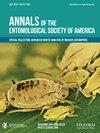更正:“结束了皮蛛的生命周期”(膜翅目:鞘翅目)
IF 1.8
3区 农林科学
Q1 ENTOMOLOGY
引用次数: 0
摘要
虽然无性繁殖和有性繁殖世代的交替在橡树胆蜂中很常见(膜翅目:Cynipidae:Cynipini),有人假设,显示这种独特生命周期的分类群的多样性被低估了,因为1)替代世代尚未被描述,或者2)每一代目前都被描述为两个不同的物种,应该分解为一个异卵生物(称为“结束生命周期”)。通过实地观察、实验饲养、形态鉴定、实验室行为测定和遗传分析,我们证明了食蟹纲物种Andricus quercuslanigera(Ashmead 1881)(膜翅目:食蟹科)的异卵性,该物种以前仅从无性世代开始描述。我们证实,无性一代是在得克萨斯州东南部活橡树(Quercus virginiana)叶片下侧中央静脉上的“模糊”果壳中发育的,它只代表了双伏生活周期中的一代,与新发现的在同一宿主的柳絮上的果壳中发展的性一代交替。我们的研究强调了对单性胆蜂物种生命周期进行详细检查的必要性,并根据Cynipidae异源性生态学和进化研究的最新进展,讨论了A.quercuslanigera生命周期的结束。本文章由计算机程序翻译,如有差异,请以英文原文为准。
Correction to: ‘Closing the life cycle’ of Andricus quercuslanigera (Hymenoptera: Cynipidae)
While the alternation of asexually and sexually reproducing generations is common among the oak gall wasps (Hymenoptera: Cynipidae: Cynipini), it has been hypothesized that the diversity of taxa displaying this unique life cycle is underestimated because either 1) the alternative generation has not yet been described or 2) each generation is currently described as two distinct species and should be collapsed into one heterogonic organism (referred to as ‘closing the life cycle’). Through field observations, experimental rearing, morphological identification, laboratory behavioral assays, and genetic analysis, we demonstrate heterogony in the cynipid species Andricus quercuslanigera (Ashmead 1881) (Hymenoptera: Cynipidae), which was previously only described from the asexual generation. We confirm that the asexual generation, which develops in ‘fuzzy’ galls on the central vein on the underside of leaves on live oaks in southeast Texas, Quercus virginiana , represents only one generation in a bivoltine life cycle that alternates with a newly discovered sexual generation that develops in galls on catkins on the same host. Our study highlights the need for detailed inspections of the life cycles of unisexual gall wasp species and we discuss the closure of the A. quercuslanigera life cycle in light of recent advances in the study of the ecology and evolution of heterogony in the Cynipidae.
求助全文
通过发布文献求助,成功后即可免费获取论文全文。
去求助
来源期刊
CiteScore
4.90
自引率
0.00%
发文量
25
审稿时长
6-12 weeks
期刊介绍:
The Annals of the Entomological Society of America exists to stimulate interdisciplinary dialogue across the entomological disciplines and to advance cooperative interaction among diverse groups of entomologists. It seeks to attract and publish cutting-edge research, reviews, collections of articles on a common topic of broad interest, and discussion of topics with national or international importance. We especially welcome articles covering developing areas of research, controversial issues or debate, and topics of importance to society. Manuscripts that are primarily reports of new species, methodology, pest management, or the biology of single species generally will be referred to other journals of the ESA. The most important criteria for acceptance are quality of work and breadth of interest to the readership.

 求助内容:
求助内容: 应助结果提醒方式:
应助结果提醒方式:


